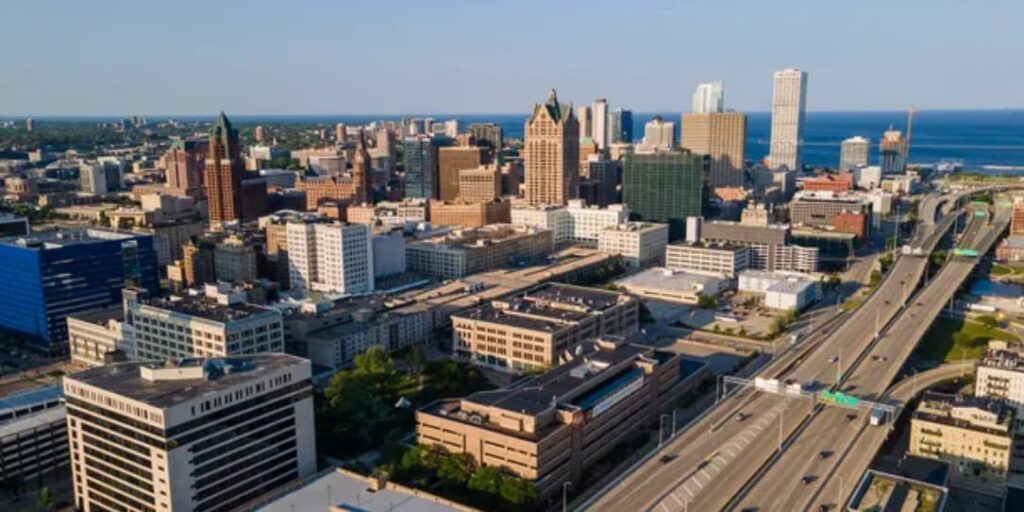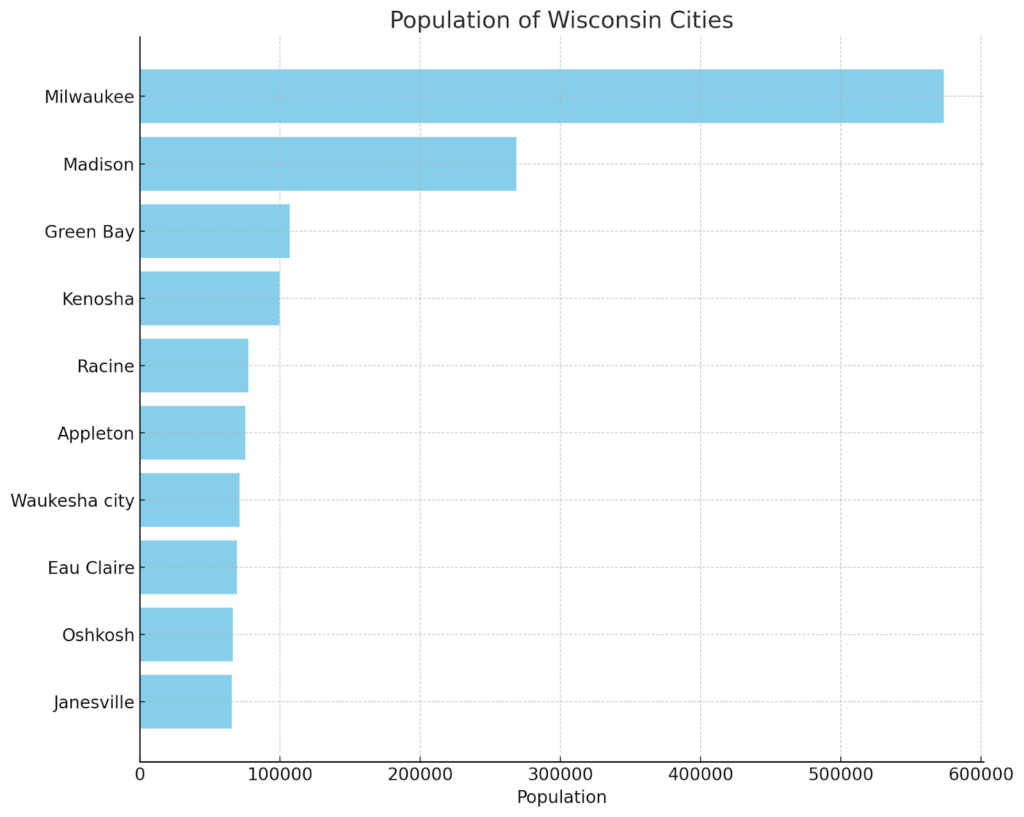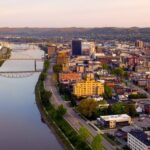
Wisconsin, known for its diverse landscapes ranging from the Great Lakes’ shores to vast forests and urban centers, is a state with a rich history and a vibrant cultural scene. It is home to a variety of cities, each with its own unique charm and character. This article takes a closer look at the top 10 most populous cities in Wisconsin, showcasing the diversity and vibrancy of urban life across the state.
What are the Top Wisconsin Cities by Population?

1. Milwaukee (Population: 573,299)
Milwaukee, Wisconsin’s largest city, sits on the western shore of Lake Michigan. Known for its brewing traditions, Milwaukee is much more than just a haven for beer enthusiasts. The city boasts a vibrant arts scene, including the Milwaukee Art Museum with its striking architecture. Its diverse cultural festivals, such as Summerfest, the world’s largest music festival, reflect the city’s rich ethnic heritage. Milwaukee’s revitalized downtown area, including the Historic Third Ward, offers a variety of shops, restaurants, and entertainment options, making it a dynamic urban center. Additionally, Milwaukee’s commitment to education and innovation is evident in its numerous universities and colleges, as well as in initiatives like the Milwaukee Tech Hub, aimed at fostering tech growth and talent development. The city’s lakefront location also offers ample opportunities for water-related activities and events, further enhancing its appeal as a place to live and visit. Milwaukee’s blend of cultural, historical, and modern elements makes it a compelling destination for all.
2. Madison (Population: 268,516)
Madison, the state capital and home to the University of Wisconsin, is known for its political activism and educational prominence. Nestled between Lakes Mendota and Monona, it offers stunning natural beauty and a plethora of outdoor activities year-round. The city’s vibrant cultural scene is evident in its local music, a variety of festivals, and a strong commitment to the arts. Madison’s progressive atmosphere, combined with its friendly, small-town vibe, makes it a unique blend of urban and natural elements. The city is also a hub for innovation and entrepreneurship, with a growing technology sector and supportive community for startups. Madison’s commitment to sustainability is visible in its extensive bike trails, public transportation systems, and conservation efforts. The city’s educational institutions not only provide top-tier education but also contribute to the lively cultural and social landscape, making Madison a nurturing environment for students, professionals, and families alike.
3. Green Bay (Population: 106,846)
Famous for its die-hard football fans and the legendary Lambeau Field, Green Bay holds a special place in the hearts of sports enthusiasts. Beyond football, the city has much to offer, from the Green Bay Botanical Garden to the National Railroad Museum. Green Bay’s economy benefits from a mix of manufacturing, transportation, and health care sectors. The community spirit in Green Bay is strong, with residents taking great pride in their city and its history. The city also values its cultural and environmental heritage, as seen in the preservation of historic sites and the development of green spaces like the Bay Beach Wildlife Sanctuary. Green Bay’s educational system supports a robust community, with a range of schools and colleges fostering the next generation. The city’s commitment to community engagement is evident in its numerous festivals and events that celebrate its diversity and unity. From sports to culture and education, Green Bay offers a quality of life that blends tradition with progress.
4. Kenosha (Population: 99,493)
Located on the southwestern shore of Lake Michigan, Kenosha is a city with a rich history and a vibrant present. It offers a variety of attractions, from the Kenosha Public Museum and Dinosaur Discovery Museum to the electric streetcar system that provides a nostalgic way to explore the city. Kenosha’s revitalized downtown area features an array of shops, restaurants, and cultural venues. The city’s location makes it a popular destination for those seeking waterfront activities and events.
5. Racine (Population: 77,453)
Racine, situated along the shores of Lake Michigan, is known for its architectural marvels, including works by Frank Lloyd Wright. The city’s strong industrial base is complemented by a commitment to the arts, as seen in the Racine Art Museum. The Wind Point Lighthouse and North Beach offer picturesque views and recreational opportunities. Racine’s diverse community and economic initiatives are driving its evolution into a city that honors its past while looking towards the future. In addition to its architectural and cultural landmarks, Racine is working towards economic diversification and sustainability, with initiatives aimed at fostering innovation and technology-based industries. The city’s educational institutions, including the University of Wisconsin-Parkside and Gateway Technical College, play a crucial role in preparing the workforce for these emerging sectors. Community events, such as the annual Racine Fourth Fest, one of the Midwest’s largest Fourth of July parades, and the Dragon Boat Races, celebrate the city’s community spirit and multicultural heritage. With its beautiful lakefront, vibrant cultural scene, and forward-looking economic development strategies, Racine offers a unique blend of historical richness and modern living.
6. Appleton (Population: 75,133)
Appleton combines small-town charm with urban amenities, making it an attractive place to live and visit. Home to Lawrence University, the city boasts a strong educational environment and a vibrant arts scene, highlighted by the Fox Cities Performing Arts Center. Appleton’s rich history is preserved in its well-maintained historic homes and buildings, especially along College Avenue. The city’s community events, including the annual Mile of Music festival, showcase its lively spirit and cultural diversity. Beyond its cultural and educational offerings, Appleton is dedicated to community wellness and green initiatives, with numerous parks and nature preserves, such as High Cliff State Park, providing outdoor activities and natural beauty. The city’s economy is supported by a mix of manufacturing, healthcare, and retail sectors, with a growing emphasis on technology and innovation. Appleton’s commitment to community engagement and development is evident in its efforts to enhance downtown areas, support local businesses, and maintain a high quality of life for its residents. This blend of cultural richness, educational excellence, and community focus makes Appleton a welcoming and vibrant city.
7. Waukesha city (Population: 70,945)
Waukesha, with its scenic riverfront and vibrant downtown, is a city that prides itself on its community spirit and quality of life. The city’s history as a spring water resort town is still evident in its beautiful parks and recreational areas. Waukesha’s cultural scene includes the Carroll University arts programs and a variety of festivals throughout the year. The city’s ongoing revitalization efforts aim to enhance its historic charm while accommodating modern urban living. Waukesha’s focus on sustainable living and environmental conservation is reflected in its efforts to protect its natural springs and promote green spaces within urban areas. The Waukesha County Historical Society and Museum, along with the Les Paul Performance Center, celebrate the city’s rich history and notable residents. Economic development initiatives have aimed at diversifying the city’s economy, encouraging growth in sectors such as healthcare, education, and technology. Waukesha’s community-centric approach, combined with its commitment to preserving its unique heritage and embracing future opportunities, makes it a city that balances tradition with innovation.
8. Eau Claire (Population: 69,098)
Eau Claire, where the Eau Claire and Chippewa Rivers meet, is a city known for its strong music and arts culture. The city’s transformation in recent years has led to a resurgence of local businesses, arts venues, and public spaces. Eau Claire’s music festivals, such as the Eaux Claires festival, have gained national attention. The city’s commitment to community and sustainability is evident in its parks, bike trails, and the revitalization of its downtown area.
9. Oshkosh (Population: 66,373)
Oshkosh is not just about the annual EAA AirVenture Oshkosh, the world’s largest aviation event; it’s a city with a robust educational system, anchored by the University of Wisconsin-Oshkosh. The city’s manufacturing base is complemented by a growing service sector. Oshkosh’s Menominee Park, Lake Winnebago, and the Oshkosh Public Museum are just a few attractions that make it a great place for families and individuals alike. Additionally, Oshkosh fosters a vibrant cultural scene, with the Grand Opera House and a variety of local galleries offering an array of artistic experiences. The downtown area, with its blend of historic buildings and modern amenities, hosts numerous community events and festivals that bring together residents and visitors. Oshkosh’s commitment to sustainability and community wellness is evident in its extensive parks system and initiatives like the Riverwalk, which provides scenic views and opportunities for outdoor activities. This blend of cultural, educational, and recreational resources makes Oshkosh a dynamic city that celebrates its heritage while looking forward to the future.
10. Janesville (Population: 65,669)
Janesville, known as “Wisconsin’s Park Place,” offers a blend of urban culture and natural beauty. The city’s extensive park system, including the Rotary Botanical Gardens, provides ample opportunities for recreation and relaxation. Janesville’s commitment to economic development and community engagement is evident in its revitalized downtown and active cultural scene. The city’s history as a manufacturing and agricultural hub continues to shape its identity and growth.
Each of these cities contributes uniquely to the tapestry of Wisconsin, offering a glimpse into the state’s diverse urban landscapes. From Milwaukee’s bustling streets to Janesville’s scenic parks, Wisconsin’s cities are vibrant communities with rich histories and promising futures.
Last modified: February 29, 2024

